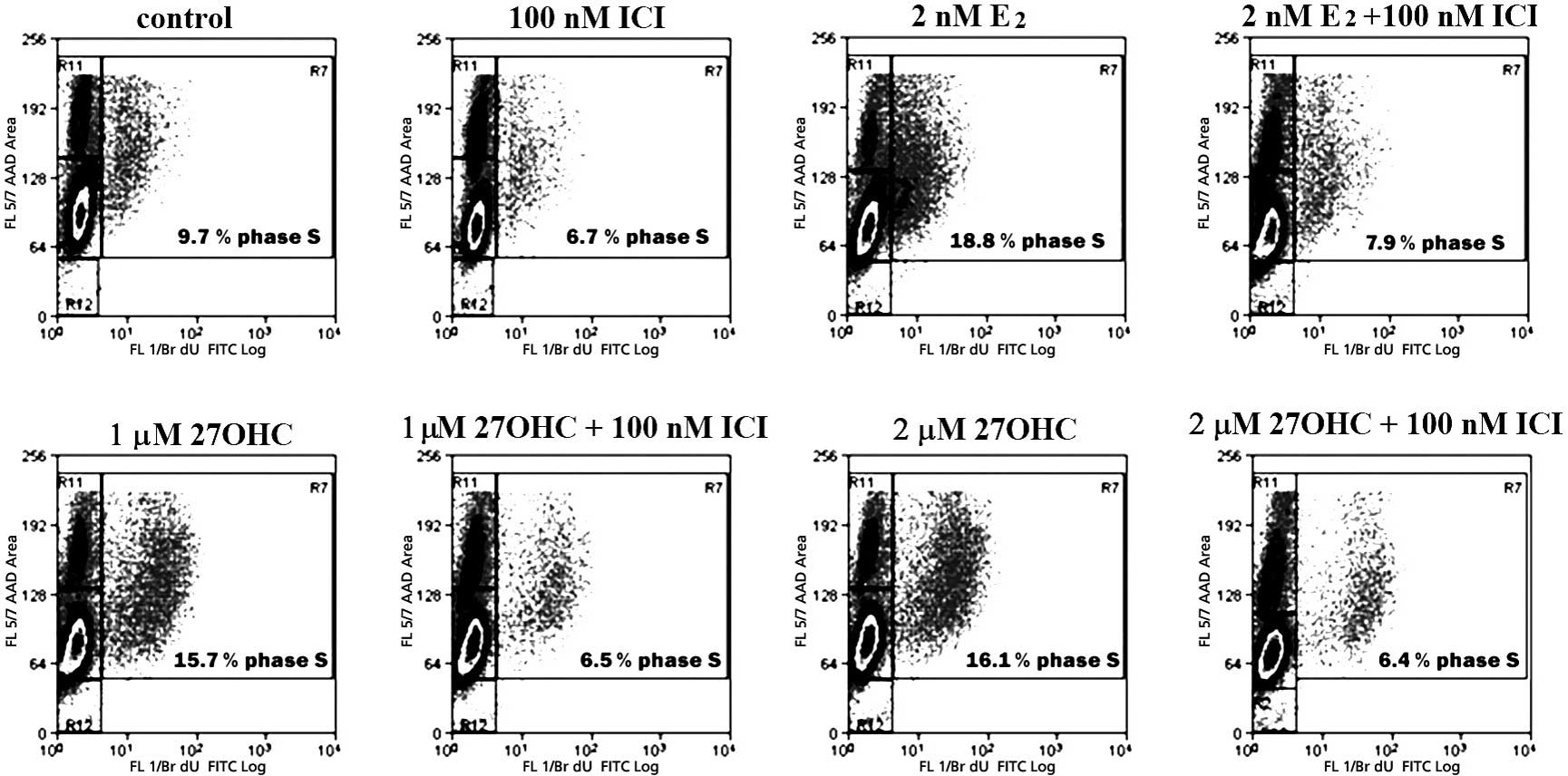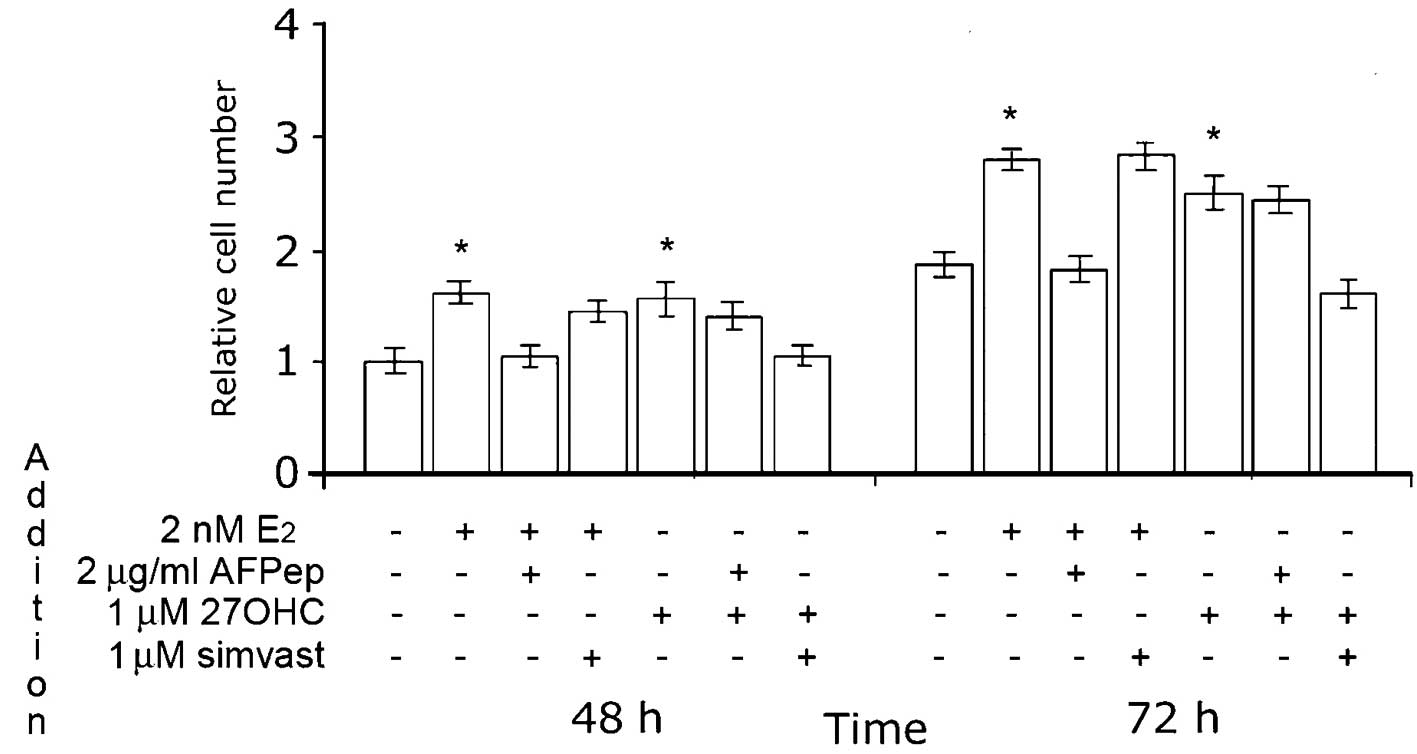|
1.
|
Russo IH and Russo J: Role of hormones in
mammary cancer initiation and progression. J Mammary Gland Biol
Neoplasia. 3:49–61. 1998. View Article : Google Scholar : PubMed/NCBI
|
|
2.
|
Conzen SD: Nuclear receptors and breast
cancer. Mol Endocrinol. 22:2215–2228. 2008. View Article : Google Scholar : PubMed/NCBI
|
|
3.
|
Fox EM, Andrade J and Shupnik MA: Novel
actions of estrogen to promote proliferation integration of
cytoplasmic and nuclear pathways. Steroids. 74:622–627. 2009.
View Article : Google Scholar : PubMed/NCBI
|
|
4.
|
Madak-Erdogan Z, Kieser KJ, Kim SH, Komm
B, Katzenellenbogen JA and Katzenellenbogen BS: Nuclear and
extranuclear pathway inputs in the regulation of global gene
expression by estrogen receptors. Mol Endocrinol. 22:2116–2127.
2008. View Article : Google Scholar : PubMed/NCBI
|
|
5.
|
He J, Cheng Q and Xie W: Minireview:
nuclear receptor-controlled steroid hormone synthesis and
metabolism. Mol Endocrinol. 24:11–21. 2010. View Article : Google Scholar : PubMed/NCBI
|
|
6.
|
Sasano H, Suzuki T, Nakata T and Moriya T:
New development in intracrinology of breast carcinoma. Breast
Cancer. 13:129–136. 2006. View Article : Google Scholar : PubMed/NCBI
|
|
7.
|
Arpino G, Weichmann L, Osborne CK and
Schiff R: Crosstalk between the estrogen receptor and the HER
tyrosine kinase receptor family: molecular mechanism and clinical
implications for endocrine therapy resistance. Endocr Rev.
29:217–233. 2008. View Article : Google Scholar
|
|
8.
|
Hall JM and McDonnell DP: Coregulators in
nuclear estrogen receptor action: from concept to therapeutic
targeting. Mol Interv. 5:343–357. 2005. View Article : Google Scholar : PubMed/NCBI
|
|
9.
|
Shelly W, Draper MW, Krishnan V, Wong M
and Jaffe RB: Selective estrogen receptor modulators: an update on
recent clinical findings. Obstet Gynecol Surv. 63:163–181.
2008.PubMed/NCBI
|
|
10.
|
Umetani M, Domoto H, Gormley AK, Yuhanna
IS, Cummins CL, Javitt NB, Korach KS, Shaul PW and Mangelsdorf DJ:
27-Hydroxycholesterol is an endogenous SERM that inhibits the
cardiovascular effects of estrogens. Nature Med. 13:1185–1192.
2007. View
Article : Google Scholar : PubMed/NCBI
|
|
11.
|
DuSell CD, Umetani M, Shaul PW,
Mangelsdorf DJ and McDonnell DP: 27-Hydroxycholesterol is an
endogenous selective estrogen receptor modulator. Mol Endocrinol.
22:65–77. 2008. View Article : Google Scholar : PubMed/NCBI
|
|
12.
|
Brown AJ and Jessup W: Oxysterols and
atherosclerosis. Atherosclerosis. 142:1–28. 1999. View Article : Google Scholar
|
|
13.
|
Hirayama T, Mizokami Y, Honda A, Homma Y,
Ikegami T, Saito Y, Miyazaki T and Matsuzaki Y: Serum concentration
of 27-hydroxycholesterol predicts the effects of high-cholesterol
diet on plasma LDL cholesterol level. Hepatol Res. 39:149–156.
2009. View Article : Google Scholar : PubMed/NCBI
|
|
14.
|
Babiker A, Dzeletovic S, Wiklund B,
Pettersson N, Salonen J, Nyyssönen K, Eriksson M, Diczfalusy U and
Björkhem I: Patients with atherosclerosis may have increased
circulating levels of 27-hydroxycholesterol and cholestenoic acid.
Scand J Clin Lab Invest. 65:365–375. 2005. View Article : Google Scholar : PubMed/NCBI
|
|
15.
|
Hultén LM, Lindmark H, Diczfalusy U,
Björkhem I, Ottosson M, Liu Y, Bondjers G and Wiklund O: Oxysterols
present in atherosclerotic tissue decrease the expression of
lipoprotein lipase messenger RNA in human monocyte-derived
macrophages. J Clin Invest. 97:461–468. 1996.PubMed/NCBI
|
|
16.
|
Olkkonen VM and Hynynen R: Interactions of
oxysterols with membranes and proteins. Mol Aspects Med.
30:123–133. 2009. View Article : Google Scholar : PubMed/NCBI
|
|
17.
|
Lemaire-Ewing S, Prunet C, Montange T,
Vejux A, Berthier A, Bessede G, Corcos L, Gambert P, Neel D and
Lizard G: Comparison of the cytotoxic, pro-oxidant and
pro-inflammatory characteristics of different oxysterols. Cell Biol
Toxicol. 21:97–114. 2005. View Article : Google Scholar : PubMed/NCBI
|
|
18.
|
Riendeau V and Garenc C: Effect of
27-hydroxycholesterol on survival and death of human macrophages
and vascular smooth muscle cells. Free Radic Res. 43:1019–1028.
2009. View Article : Google Scholar : PubMed/NCBI
|
|
19.
|
Li T, Chen W and Chiang JY: PXR induces
CYP27A1 and regulates cholesterol metabolism in the intestine. J
Lipid Res. 48:373–384. 2007. View Article : Google Scholar : PubMed/NCBI
|
|
20.
|
Oyama T, Miyashita Y, Kinoshita K,
Watanabe H, Shirai K and Yagima T: Effect of deposited lipids in
atheromatous lesions on the migration of vascular smooth muscle
cells. J Atheroscler Thromb. 9:109–113. 2002. View Article : Google Scholar : PubMed/NCBI
|
|
21.
|
Kummerow FA, Mahfouz MM, Zhou Q and Cook
LS: 27-Hydroxycholesterol causes remodeling in endothelial cell
membrane lipid composition comparable to remodeling in the failed
vein grafts of CABG patients. Life Sci. 78:958–963. 2006.
View Article : Google Scholar : PubMed/NCBI
|
|
22.
|
Lange Y, Ory DS, Ye J, Lanier MH, Hsu FF
and Steck TL: Effectors of rapid homeostatic responses of
endoplasmic reticulum cholesterol and
3-hydroxy-3-methylglutaryl-CoA reductase. J Biol Chem.
283:1445–1455. 2008. View Article : Google Scholar : PubMed/NCBI
|
|
23.
|
Sierralta WD, Epuñán MJ, Reyes JM,
Valladares LE, Andersen TT, Bennett JA, Jacobson HI and Pino AM: A
peptide derived from α-fetoprotein inhibits the proliferation
induced by estradiol in mammary tumor cells in culture. Oncol Rep.
19:229–235. 2008.
|
|
24.
|
Sierralta WD, Epuñán MJ, Reyes JM,
Valladares LE and Pino AM: A cyclic nonapeptide derived from
alpha-fetoprotein inhibits the estradiol-induced proliferation of
mammary tumor cells in culture through the modulation of p21. Adv
Exp Med Biol. 617:463–468. 2008. View Article : Google Scholar
|
|
25.
|
Torres C, Antileo E, Epuñán MJ, Pino AM,
Valladares LE and Sierralta WD: A cyclic peptide derived from
α-fetoprotein inhibits the proliferative effects of the epidermal
growth factor and estradiol in MCF7 cells. Oncol Rep. 19:1597–1603.
2008.
|
|
26.
|
Torres CG, Pino AM and Sierralta WD: A
cyclized peptide derived from α-fetoprotein inhibits the
proliferation of ER-positive canine mammary cancer cells. Oncol
Rep. 21:1397–1404. 2009.
|
|
27.
|
DuSell CD and McDonnell DP:
27-Hydroxycholesterol: a potential endogenous regulator of estrogen
receptor signaling. Trends Pharmacol Sci. 29:510–514. 2008.
View Article : Google Scholar : PubMed/NCBI
|
|
28.
|
Lange Y, Steck TL, Ye J, Lanier MH, Molugu
V and Ory D: Regulation of fibroblast mitochondrial
27-hydroxycholesterol production by active plasma membrane
cholesterol. J Lipid Res. 50:1881–1888. 2009. View Article : Google Scholar : PubMed/NCBI
|
|
29.
|
Steele RJ, Eremin O, Brown M and Hawkins
RA: A high macrophage content in human breast cancer is not
associated with favourable prognostic factors. Br J Surg.
71:456–458. 1984. View Article : Google Scholar : PubMed/NCBI
|
|
30.
|
Javitt NB: 25R,26-Hydroxycholesterol
revisited: synthesis, metabolism and biologic roles. J Lipid Res.
43:665–670. 2002.PubMed/NCBI
|
|
31.
|
Chen W, Chen G, Head DL, Mangelsdorf DJ
and Russell DW: Enzymatic reduction of oxysterols impairs LXR
signaling in cultured cells and the livers of mice. Cell Metab.
5:73–79. 2007. View Article : Google Scholar : PubMed/NCBI
|
|
32.
|
Vedin LL, Lewandowski SA, Parini P,
Gustafsson JÅ and Steffensen KR: The oxysterol receptor LXR
inhibits proliferation of human breast cancer cells.
Carcinogenesis. 30:575–579. 2009. View Article : Google Scholar : PubMed/NCBI
|
|
33.
|
Culhane AC and Howlin J: Molecular
profiling of breast cancer: transcriptomic studies and beyond. Cell
Mol Life Sci. 64:3185–3200. 2007.PubMed/NCBI
|















